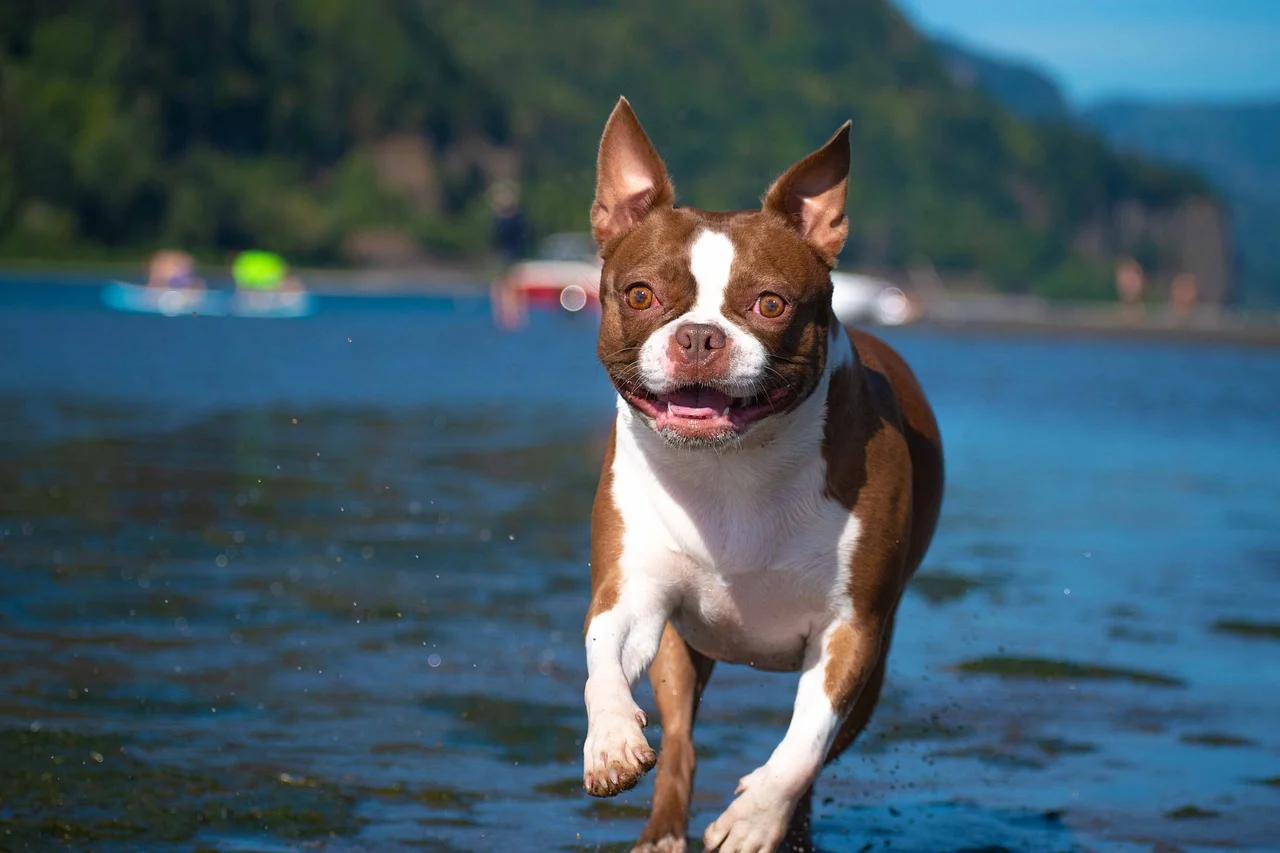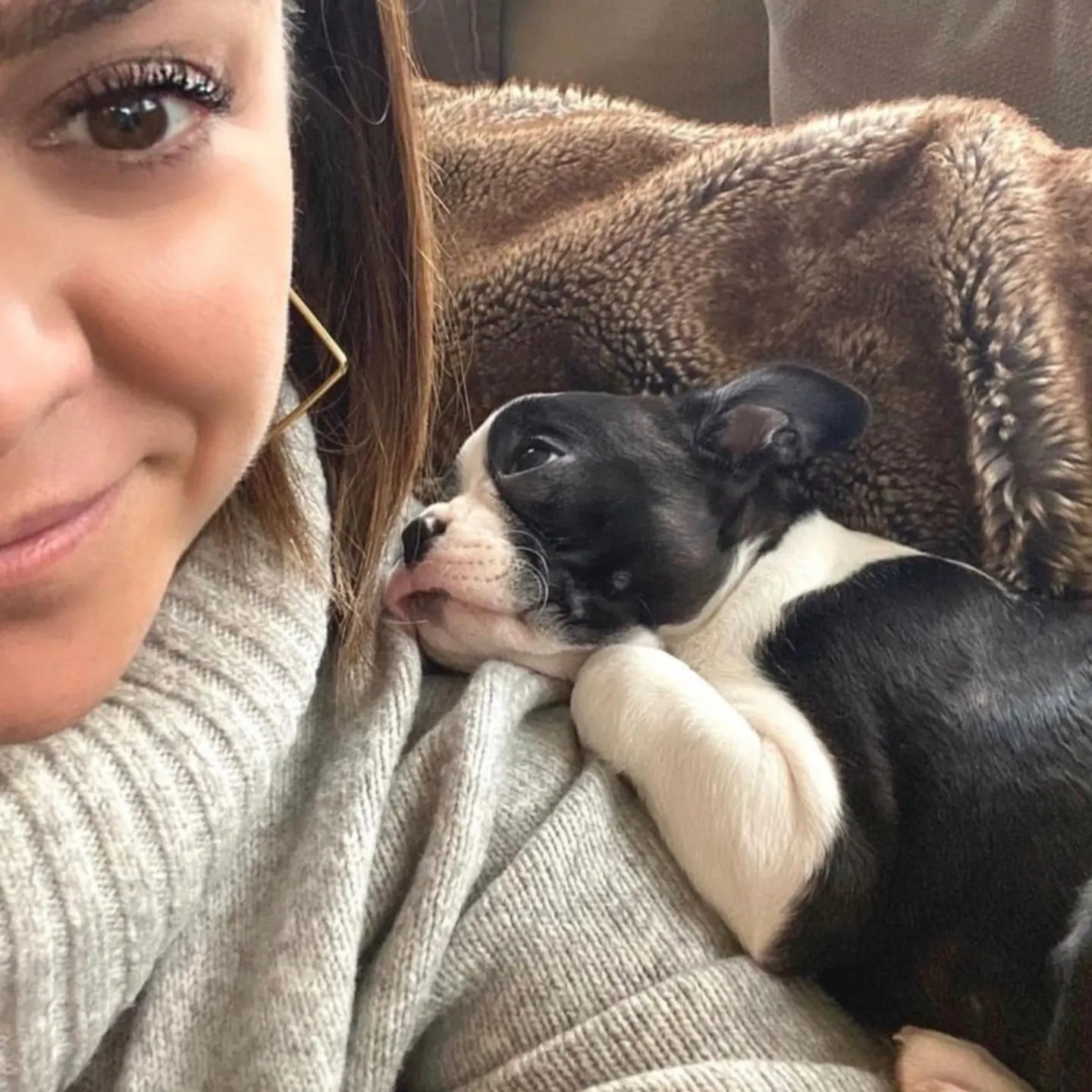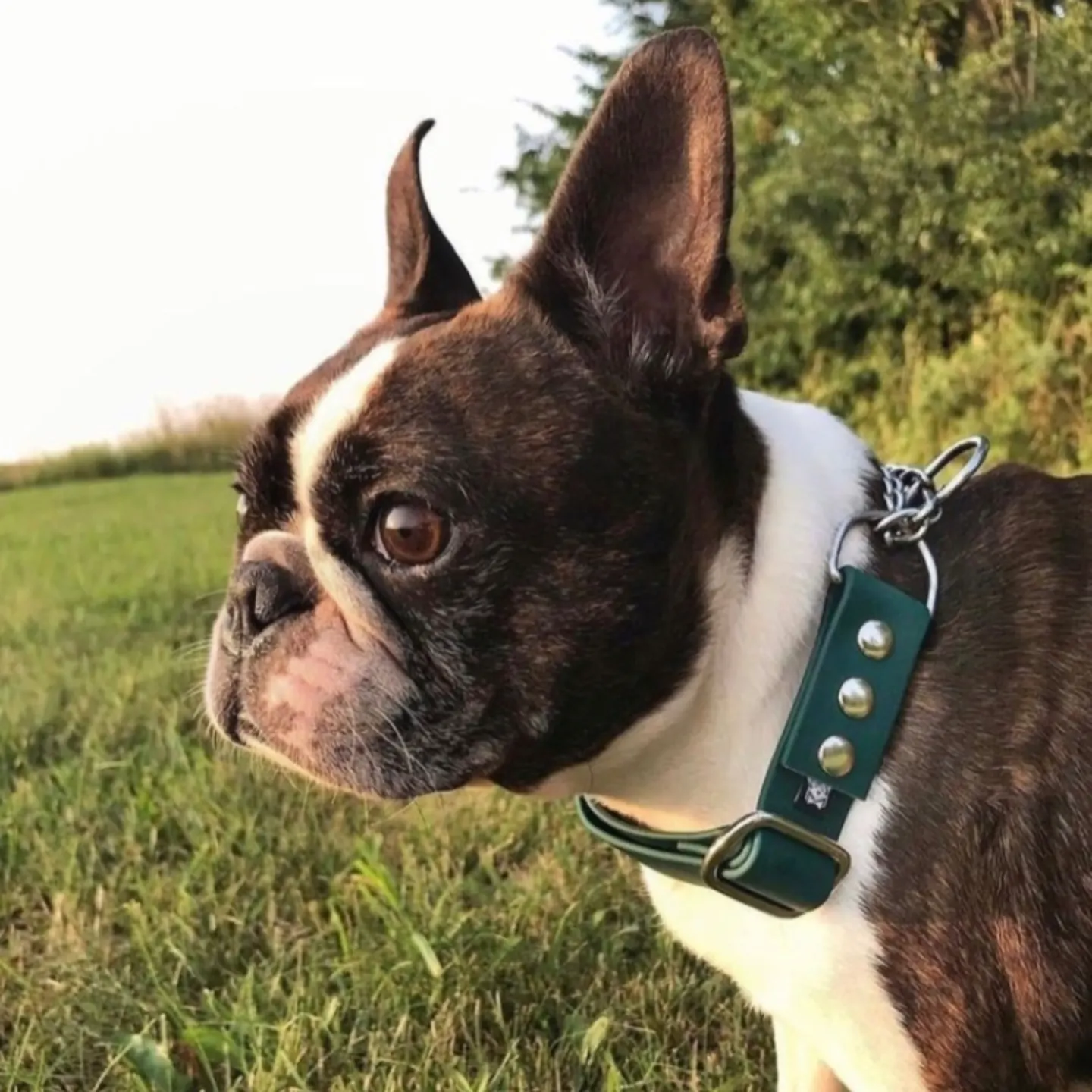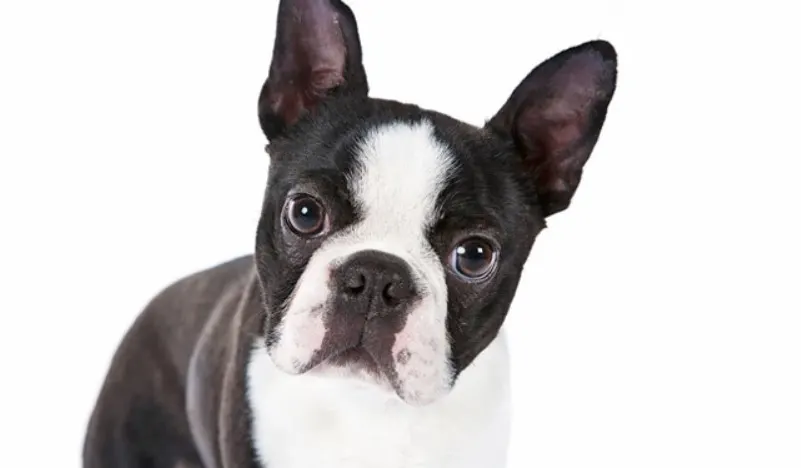While it may not seem like it today, the American Gentleman, also known as the Boston Terrier, was once bred to be a fierce pit fighter. Pretty hard to believe it, right? But nowadays, these adorable dogs are no fighters at all. In fact, we would describe them more as loving clowns. As they not only show us deep affection but know how to make us laugh as well. That does not mean that these canines don’t have a protective side. Boston Terriers, especially males, will protect their owners and territory no matter what!People say that Boston Terriers are very smart, sometimes too much so. Their friendly, active personalities make them very popular, but they can get in trouble with their owners if they are too stubborn or act too quickly. But when they look up at you with those big, round eyes that seem to say “I love you,” you quickly forget about how they act.
Even though they are small, Boston Terriers are strong and muscular. They have a smooth, shiny, straight coat with white markings that look like a tuxedo. This is one reason why they got the name “American Gentleman.” The ears of Boston Terriers are very big and stand up on their own. Also, they have big, beautiful eyes that are quite far apart, which adds to their already stunning looks.
They would make a great family dog for many different types of families, however, if you decide to get one of these dogs, you need to take into consideration that they are a brachycephalic breed. That means that their adorable ‘squished’ face makes it hard for them to breathe normally. You need to take extra care of these dogs because they don’t tolerate difficult exercise or extremely hot weather conditions.
History of the Boston Terrier
Even though everyone agrees that the Boston Terrier was created in Boston, Massachusetts in the late 1800s, there are different stories about how the breed came to be.
One story says that coachmen for wealthy families created the breed by crossing English Bulldogs and the now-extinct English White Terrier to make a new dog-fighting breed. Another story says that in 1865, a man from Boston named Robert C. Hooper brought Judge from England because the dog reminded him of a dog he had as a child.
Another story says that Hooper bought Judge around 1870 from a fellow Bostonian named William O’Brian. We may never know which story is true, but the fact is that there was a dog named Judge, and from him came the Boston Terrier breed we know today.
About 30 Boston Bull Terrier owners got together in 1889 to form the American Bull Terrier Club. They called their dogs Round Heads or Bull Terriers. Fans of Bull Terriers and Bulldogs didn’t like the name. Because of this, Boston Bull Terrier owners decided that it was best to change the name of their club to the Boston Terrier Club. People began to call the breed “Boston Bulls.” The Boston Terrier was one of the first non-sporting dogs to be bred in the United States. It was also the first of the 10 breeds that were made in America and are now recognized by the American Kennel Club.
Boston Terriers caught on quickly in the U.S. In the U.S., Boston Terriers were the most popular breed in 1915. They stayed in the top ten until the 1960s. In 1976, the Boston Terrier was chosen to be the official dog of the United States’ 200th birthday. Three years later, he was named the Massachusetts state dog.
Appearance and physical characteristics
It’s easy to see why Boston terriers are called “the American Gentlemen.” They have a tuxedo-like coat and big, dark eyes. One more thing that makes Boston terriers stand out is that they have big, dark, round eyes that are set far apart. The eyes of these dogs make them look even more adorable. In fact, the breed standards say that the dog’s best expression is “alert and kind, showing a high level of intelligence.” And we could not agree more with that.
The Boston Terrier Club of America says that the breed standards call for a black, brindle, or seal coat that is evenly marked with white. A seal coat is black but has a red tint when your Boston is in the sun. He has white marks on his chest and between his eyes, which look like a stripe. Boston terriers can also be red, brown, or blue, but black-and-white is the most common color. They have a smooth, short coat and they don’t shed much at all.
The face of a Boston Terrier is wide and flat, and there are no wrinkles on it. They are a brachycephalic dog breed, as we already explained. As with other brachycephalic dogs, their lower jaw is the right size for their body, but their upper jaw is short, giving them a “pushed-in” look. While this does look cute, it comes with various different health issues.
The way Boston Terriers walk makes them seem bigger than they are. They have a proud neckline with a slight arch, a wide chest, and a strong, boxy look. Their tails are short and set low on their backs. Boston terriers are athletic dogs with strong, muscular thighs. Most of these dogs weigh between 12 and 25 pounds and are small but strong.
How do Boston Terriers compare to French Bulldogs?
If you are as crazy about dogs as we are, there is no question that you could easily differentiate a Boston Terrier from a French Bulldog. However, people who are newbies in the canine world, or just aren’t as obsessed with knowing every dog breed there is, might think that these two are the same breed. That’s why we will quickly explain the biggest differences between these two dog breeds.
The biggest difference is possibly the one in its size and body shape. Frenchies have bigger bones, and Boston Terriers have longer legs. The French Bulldog has the signature “bulky” body which would make it harder to pick them up. Boston Terriers are overall much leaner and taller canines.
Also, their ears are not the same. The ears of a Boston Terrier stand up and are sharp. The French Bulldog has “bat” ears, which means they are a lot more oval-shaped. But the Boston Terrier and the French Bulldog are most different because of the color of their coats. Both breeds are usually black and white, but terriers are often two colors, with an even mix of white and black, brown, liver, or seal. Also, he has a white stripe between his eyes almost all the time.
We have a whole article all about the Boston Terrier VS French Bulldog comparison.
Boston Terrier Colors
We already explained which the most common Boston Terrier colors are. All of them have those signature white markings, and these are the most common color combinations:
- Black and White
- Black Brindle and White
- Brindle and White
- Seal and White
- Seal Brindle and White
However, many people don’t know that there are some rare color variations of these purebred dogs as well. So let’s take a look at them too, shall we?
Red Boston Terrier
Red Boston Terriers are just regular Boston Terriers with liver coloring. They are not that rare, but most national kennel clubs don’t recognize them because of their coloring. The best places for these dogs are apartments and busy families. They are small and compact, but they need to move around a bit every day.
When well-socialized, they are easy to train and get along with most animals and people. But they need to be socialized early on because they can be protective of their main owner. Because they have short faces, they are also not very healthy.
The price of a red Boston Terrier shouldn’t be higher than the price of a regular Boston Terrier. Some breeders might try to sell them for more money by saying they are “rare.” But they aren’t that rare, and they shouldn’t cost more than a typical Boston Terrier.

There are a few differences between the red Boston Terrier and standard Boston Terriers
Blue Boston Terrier
Blue is just another word for a grey Boston Terrier in the language of dog coat colors. It means a cool grey coat made by diluting the color of black fur. This is the result of a gene mutation on chromosome 28.
Blue is not a common coat color for Boston terriers. This means that a Boston Terrier that is blue and white can’t enter confirmation shows. But blue coats are a possibility for the breed, and one of the original dogs was blue.
Blue Puppies with grey eyes can sometimes look like they have light blue eyes. But as they get older, their eyes will get darker and turn a hazel-brown color. These dogs are pretty rare. You won’t see this color very often. Also, for this color to happen, both parents must have the gene that makes the black coat dilute.
Personality of the Boston Terrier
The Boston Terrier is known as the “American Gentleman” because he is friendly, smart, full of life, and looks like he is wearing a tuxedo. He also has a calm, even temperament. They can be stubborn, though, so you have to train them with persistence and consistency, and you have to start socializing them early.
Socializing your Boston puppy helps make sure he or she grows up to be a well-rounded dog. Boston terriers are great apartment dogs because they are small and don’t need a lot of exercise. They also love to cuddle up on the couch. Boston terriers can be good family dogs that get along well with other pets and older children, whether you get them as puppies or adopt them.
These little dogs are very loyal and love to spend time with their owners. But they are shy around new people, so it’s important to get them used to people as soon as possible. Most of the time, they are quiet, gentle dogs that don’t bark or act badly. Also, they get along well with other animals.
The Boston Terrier is a simple dog that doesn’t need a lot of exercise. Still, this doesn’t mean they don’t need any exercise at all. You have to walk them a few times a day, but the walks don’t have to be long.
Many people consider Boston Terriers to be a ‘Velcro dog breed‘. That basically means that they will stick to their owners like a velcro roller. They love to spend time with you, or when you are busy, at least be in the same room as you. These dogs will only leave your side when they have you, and you will always have a companion to do things with.

Source: Instagram (@bostonterrierloversig)
Living needs of Boston Terriers
Since their name comes from a big city, it’s no surprise that Boston terriers can do well in cities and even live in apartments, as long as they have enough room. They will be fine in a big living room or a small outdoor space, as long as you give them time to run around.
Bostons want to be your best friend, so they love nothing more than to spend time with their people. These happy dogs would love to go for a walk with you and then snuggle on the couch. However, if they are left alone for too long, they can get separation anxiety.
The Boston Terrier is good with kids and likes to play with them. He is small enough that he won’t knock them over, but big enough that he won’t get hurt easily. He gets along well with other dogs and cats, especially if he is introduced to them when he is young.
Grooming needs
The light, smooth coats of Boston terriers make them easier to groom than many other dogs because they don’t shed as much. You only have to brush them once a week. You can help pick up their loose hairs with a soft-bristled brush or a rubber grooming mitt. Like all dogs, they need to have their nails trimmed regularly. If their nails are too long, it can hurt them to walk or make them more likely to get an infection. A bath now and then keeps them smelling good, too.
Boston terriers are easier to groom than many other breeds because their coats are short and smooth. But you still need to brush their teeth every day and give them a bath once in a while. Brushing their teeth regularly will keep dog teeth problems away, and in addition to that, your dog won’t have that bad smelling breath. Finally, also make sure to clean their ears with a cotton ball and some cleaning solution every once in a while.
Training
Boston Terriers are playful, but they can become rowdy, so it’s important to train them so they learn good habits and get used to people and other dogs. Just like with any other dog, use positive reinforcement to make training fun and effective. When they are being trained, Bostons are eager to please, very smart, and love praise. Treats and pats on the head are great for these sensitive but friendly dogs.
Socializing is especially important for these dogs, so make sure you introduce them to different people and animals from their early days. That will make sure that your adorable dog will grow up to be even-tempered and friendly.
They are very sensitive dogs as well, which means they will also be sensitive to your tone of voice. Never yell at them, and please be careful how you discipline your Boston Terrier. According to experts, training should be motivational. Try and use positive techniques such as food rewards, praise, and play to teach them.
Exercise
Boston Terriers are simple dogs, they don’t need much exercise at all. Of course, this doesn’t mean they don’t need any exercise at all. You definitely need to take them out on several walks a day, but they can be kept short. Also, remember that they can’t handle extreme cold or heat. Indoors they will be calm and will usually just chill on the couch.
Different Boston terriers need different amounts of exercise, two walks a day should be enough to keep them in good shape. Boston terriers that are very active might need to play and run even more to burn off even more energy. Most likely, these dogs won’t run around the backyard by themselves. They want you to play with them by throwing them a ball or playing tug of war. Make sure you have a place with a fence where you can play with your dog.
Boston Terrier health conditions
Now that you know so much about these adorable dogs, you might be wondering how long they are going to live with you, and if they are generally healthy. These small dogs usually live for 11–13 years. As with any breed, Boston terriers are more likely to have certain health problems that you should watch out for.
Because Boston Terriers are brachycephalic, they often have breathing problems. This means that their owners should make sure to give them breaks when they need them, especially when it’s hot outside. They don’t do well with difficult exercise and hot and humid weather conditions. Boston terriers are also more likely than other dogs to have eye health problems because their eyes are so big and stand out. Owners should be on the lookout for signs of irritation or infection and check their pets often.
Some Boston terriers also have problems with their bones and joints, which can make it hard for them to move around. Bostons are more likely to have problems with their knees, and their kneecaps can slip out of place. This is called patellar luxation. They are also more likely to have hemivertebrae, which is a spine that isn’t shaped right. This can make the dog unsteady on its feet or even paralyze it. Another pretty common condition is hip dysplasia.
All of that above doesn’t mean that your dog can’t be healthy. Yes, this breed will need more vet visits than other breeds might do, but if you take care of them the right way, they will be with you for a long time. Make sure you also feed your dog a healthy and balanced diet. This breed needs to stay slim and fit in order to be as healthy as possible.

Source: Instagram (@bostonterriervibes)
Conclusion
If you are looking not only for a dog but also for a best friend, then the Boston Terrier might be the right pup for you. These small dogs are even a great choice for first-time dog owners, because they are smart, don’t need plenty of exercise, and learn quickly with the easiest training methods.
All these dogs need is a few brisk walks through the dog park, yummy and healthy food, and your full affection. They have a strong love of play, which makes them ideal for families with kids as well. Their fine coat has pretty low grooming needs and they are generally clean canines.
However, one thing that you have to take into consideration is the different health conditions and respiratory problems that they experience as a brachycephalic dog breed. Caring for these dogs long-term could be expensive. Chances are that you will have to take them to the vet pretty often, and these bills could soon add up.
But this bright dog will be so worth all of these things. It’s not only his tuxedo coat that makes them so special. Soon you will learn how big their heart is, and how capable they are to love their owners to the core!

